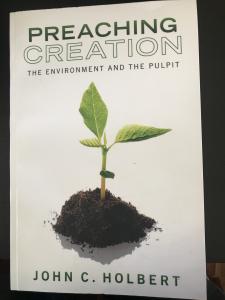 (Lectionary for November 27, 2016)I commend to you today a book written well over one hundred years ago: The Mountains of California, by that poetic botanist, John Muir. Do not be put off by the extraordinary detail concerning the flora of this Edenic part of the world. Yes, you will be exposed to more about the various sorts of pine trees in the high Sierras than perhaps you can swallow in one gulp. But the prose is lyrical in the main, and the commitment of the man to these mountains is the very stuff of legends. When we read of his walking out among the spires and glaciers, armed only with a tiny notebook, a few hunks of bread, and the makings of tea—for three or four months at a time, often in the winter, waking with snow on his face (!)—awe is the only possible response. I get cold when the temperature dips below 65 in my house; I can hardly conceive of a snow-c
(Lectionary for November 27, 2016)I commend to you today a book written well over one hundred years ago: The Mountains of California, by that poetic botanist, John Muir. Do not be put off by the extraordinary detail concerning the flora of this Edenic part of the world. Yes, you will be exposed to more about the various sorts of pine trees in the high Sierras than perhaps you can swallow in one gulp. But the prose is lyrical in the main, and the commitment of the man to these mountains is the very stuff of legends. When we read of his walking out among the spires and glaciers, armed only with a tiny notebook, a few hunks of bread, and the makings of tea—for three or four months at a time, often in the winter, waking with snow on his face (!)—awe is the only possible response. I get cold when the temperature dips below 65 in my house; I can hardly conceive of a snow-c overed nose at 12,000 feet!
overed nose at 12,000 feet!
With a very few exceptions, nearly all humans love the mountains, those craggy columns piercing the sky. Who has not marveled at pictures of Everest and Annapurna, stood astonished before the mystery of Machu Pichu, 15000 feet in the Andes of Peru, gazed in wonder at Pikes Peak thrusting skyward out of the flat plains of eastern Colorado? I am blessed to have a cabin at about 9000 feet in the Sangre de Christo Mountains of New Mexico that looks squarely at the 13,500 foot peak of Santa Fe Baldy. I picture it now as I write in Los Angeles, some 1000 miles to the west, its grandeur emblazoned on my mind’s eye. I know many of you have your favorite mountains, from the high hills of the Adirondacks to the rugged green of the Shenandoah Valley to the volcanic peaks of the Olympic Range, mountains are one of the grandest gifts of the western hemisphere.
Mountains have long played an enormous role in the shaping of civilization. Whether the splendor of Mount Fuji in Japan, or the towering fastness of the Himalayas, or the snow-capped beauty of the Alps, or the imposing and near-endless ranges of the American west, mountains have shaped and ordered the movements of human beings from the earliest days. The Bible is no exception. Again and again, mountains have served as the special place of divine activity and abode. When the psalmist cries, “I lift my eyes to the hills,” he/she echoes the actions of people from time immemorial. Humans have always, throughout recorded history, lifted their eyes to the mountains as places of wonder and power and mystery and, finally, hope.
It is little wonder that Isaiah, that city-bound prophet of 8th century BCE Israel, spoke of the highest mountains w hen he envisioned the actions of YHWH who was in the business of rearranging and at the last saving the earth from continuous depredations. Exactly when Is 2:1-5 was composed is a subject of vast scholarly energies. I have no problem imagining the oracle written in the 8th century, a time of continuous dangers for Judah and its capital Jerusalem. It is certain that Isaiah was active during the time when the northern kingdom of Israel was decimated by the Assyrian hordes, leaving Judah alone to withstand the vast armies of Sennacharib and Tiglath-Pileser. Hardly a day went by without terrifying rumors of legions of soldiers within a few days’ march of the holy city. The fact that the city was eventually spared from destruction for a time in 701 BCE had more to do with blind luck than with any supposed Israelite military prowess or divine intervention.
hen he envisioned the actions of YHWH who was in the business of rearranging and at the last saving the earth from continuous depredations. Exactly when Is 2:1-5 was composed is a subject of vast scholarly energies. I have no problem imagining the oracle written in the 8th century, a time of continuous dangers for Judah and its capital Jerusalem. It is certain that Isaiah was active during the time when the northern kingdom of Israel was decimated by the Assyrian hordes, leaving Judah alone to withstand the vast armies of Sennacharib and Tiglath-Pileser. Hardly a day went by without terrifying rumors of legions of soldiers within a few days’ march of the holy city. The fact that the city was eventually spared from destruction for a time in 701 BCE had more to do with blind luck than with any supposed Israelite military prowess or divine intervention.
It may well have had something to do with the geography of the city. Jerusalem was “Zion’s Holy Hill,” a promontory some 2000 feet above the valley of Kidron to the east and the valley of Hinnom to the south. Jerusalem was the mountain of YHWH, the site of YHWH’s sacred temple, a place that had been in existence for 300 years as the center of the life of the people of Judah. But its end appeared imminent, and Isaiah, as many of his people, began to wonder what YHWH had in mind for the chosen people who now were on the verge of doom.
His answer was Is 2:1-5. This oracle is “the thing (word) that Isaiah, son of Amoz, envisioned concerning Judah and Jerusalem” (Is 2:1). Hebrew davar may mean “word” but more generally it also may mean “thing.” Both may be intended here; it is clearly a word from YHWH, but it is at the same time a thing YHWH is about to perform. What will happen in the “latter days” or in “the days to come” is that “the mountain of YHWH’s house will be fixed as the very highest of the mountains, raised above all hills, and all nations will stream toward it” (Is 2:2). Here is prophetic imagination in full flight. Israelites well knew that the mountains of Moab in the east and the snow-capped Hermon in the far north were all mountains much taller than their beloved Zion, but in YHWH’s divine action, YHWH’s house, the temple perched atop the sacred rock of Zion, would in YHWH’s power top all mountains of the world.
And when that mountain up thrust occurs, the result will be that “all nations will stream to it. Many peoples will come and say, ‘Come, let us go up to the mountain of YHWH, to the house of the God of Jacob, in order that God may teach us God’s ways, and that we may (at last!) walk in God’s paths” (Is 2:2c-3ab). When Zion is forced higher into the sky, more nations will see, and they will come to learn the Torah, the instruction, of YHWH, and will then finally walk in the ways that YHWH has planned for the world from the beginning of the creation.
And just what are these ways? Where are these paths? What is the basic content of this Torah? The answers to these crucial questions are expressed in words that have been heard and celebrated for the 2700 years since their initial utterance. “They shall beat their swords into plowshares, their spears into pruning hooks. Nation shall not lift up sword against nation, nor shall they learn war anymore” (Is 2:4).
It is little less than astonishing that in the midst of a deeply dangerous time, when war was ever threatening, that Isaiah imagined the end of war, the beginning of peaceful human community, centered on agriculture, not the casting of weapons, on viniculture not plans for bloodshed and slaughter. Nations will learn Torah, proclaims the prophet, not war. The highest mountain of Jerusalem and its temple will be the center of the world’s school of peace and unity, not the object of defeat and destruction.
Heady words indeed! They are engraved on the United Nations building in New York City, signaling that in that place one might see the hope of a future of peace. Yet, it all seems like some cruel irony, a terrible joke. War is too much with us, as nations plot against nation and design ever more sophisticated weapons with which to kill and maim rather than turn full attention to the horrors of poverty and disease and environmental catastrophe. “Come, House of Jacob, let us all walk in the light of YHWH,” urges Isaiah, but most nations would rather walk in their own artificial lights, lamps of power and strength, rather than the fires of hope and possibility for all peoples.
It is Advent after all, that season of expectation, of waiting. Once again, we wait for the in-breaking of God, the God who refuses to stay high in the mountains but descends to the world and becomes one of us, we Christians say. That story levels the mountains rather than lifts them up beyond our reach. We stand in awe of the vast mountains of our world, and we may join Isaiah in his vision of the uprising of the hill of Zion to the world’s tallest mountain. And we may celebrate that YHWH’s Torah, God’s rejection of war and subsequent announcement of human unity, are worthy goals for all. But the incarnation of God, God’s desire at the last to be with us, to become one of us, may be the story we all need to break through the conflicts that afflict and terrorize and frighten us still. Could it be that YHWH’s Torah includes the conviction that God cares so much for us that God is fully and completely with us in our search for that elusive peace that God so desperately wants for us all?
That Psalm 121 I mentioned earlier may help us here. The psalmist does “lift eyes to hills,” but then asks, “Where does my help come from?” The immediate answer is that it does not come from the hills! “My help comes from YHWH, who made sky and earth,” and of course also the hills. It is that God who becomes one of us, that creator God, that mountain-maker, that baby in the stall, that one who loves us all and forever.
the hills. It is that God who becomes one of us, that creator God, that mountain-maker, that baby in the stall, that one who loves us all and forever.
(Images from Wikimedia Commons)











